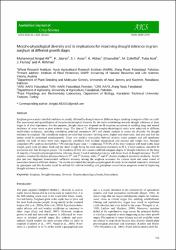| dc.contributor.author | Muhammad Amjad, Ali | |
| dc.contributor.author | K., Jabran | |
| dc.contributor.author | S. I., Awan | |
| dc.contributor.author | A., Abbas | |
| dc.contributor.author | Ehsanullah, M | |
| dc.contributor.author | M., Zulkiffal | |
| dc.contributor.author | Acet, Tuba | |
| dc.contributor.author | J., Farooq | |
| dc.contributor.author | A., Rehman | |
| dc.date.accessioned | 2019-12-18T06:51:05Z | |
| dc.date.available | 2019-12-18T06:51:05Z | |
| dc.date.issued | 2011-03-03 | |
| dc.identifier.uri | https://hdl.handle.net/20.500.12440/1729 | |
| dc.description.abstract | Sorghum grown under rain-fed conditions is usually affected by drought stress at different stages resulting in negative effect on yield. The assessment and quantification of morpho-physiological diversity for the traits contributing towards drought tolerance at these stages is of vital importance. For this purpose, drought stress was imposed on 44 sorghum accessions at seedling stage and natural incidence of water stress at post anthesis stage. The data of 21 different morpho-physiological traits were subjected to different multivariate techniques, including correlation, principal component (PC) and cluster analysis to assess the diversity for drought tolerance in sorghum. The correlation analysis revealed that selection for long roots; higher root/shoot ratio, leaf area and leaf dry matter could be performed simultaneously. There was positive association between relative water contents and cell membrane stability but both of these traits were negatively correlated with residual transpiration and excised leaf weight loss. Principal component (PC) analysis showed first 7 PCs having Eigen value >1 explaining 77.653% of the total variation with head width, head weight, grain yield per plant, fresh and dry shoot weight being the most important characters in PC1. Cluster analysis classified 44 accessions into four divergent groups. The members of first two clusters exhibited adequate degree of drought tolerance on the basis of majority of morpho-physiological traits, whereas, cluster 3 and 4 included genotypes with lower level of drought tolerance. The D2 statistics revealed the highest distances between 2nd and 3rd clusters, while 3rd and 4th clusters displayed maximum similarity. Scatter plot and tree diagrams demonstrated sufficient diversity among the sorghum accession for various traits and some extent of association between different clusters. The results concluded that morpho-physiological diversity in the studied material is structured by genotypes and this diversity could be utilized for cultivar breeding and germplasm conservation programs aimed at improving drought tolerance in sorghum. | en_US |
| dc.language.iso | eng | en_US |
| dc.rights | info:eu-repo/semantics/restrictedAccess | en_US |
| dc.subject | Sorghum. Drought tolerance | en_US |
| dc.subject | Diversity | en_US |
| dc.subject | Morpho-physiological traits | en_US |
| dc.subject | Post anthesis | en_US |
| dc.title | Morpho-physiological diversity and its implications for improving drought tolerance in grain sorghum at different growth stages | en_US |
| dc.type | article | en_US |
| dc.relation.publicationcategory | Makale - Uluslararası Hakemli Dergi - Kurum Öğretim Elemanı | en_US |
| dc.department | [Belirlenecek] | en_US |
| dc.contributor.institutionauthor | [Belirlenecek] | |


















